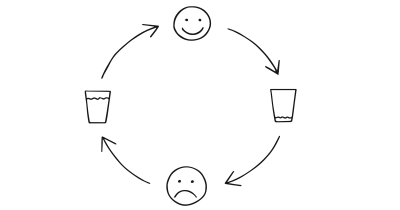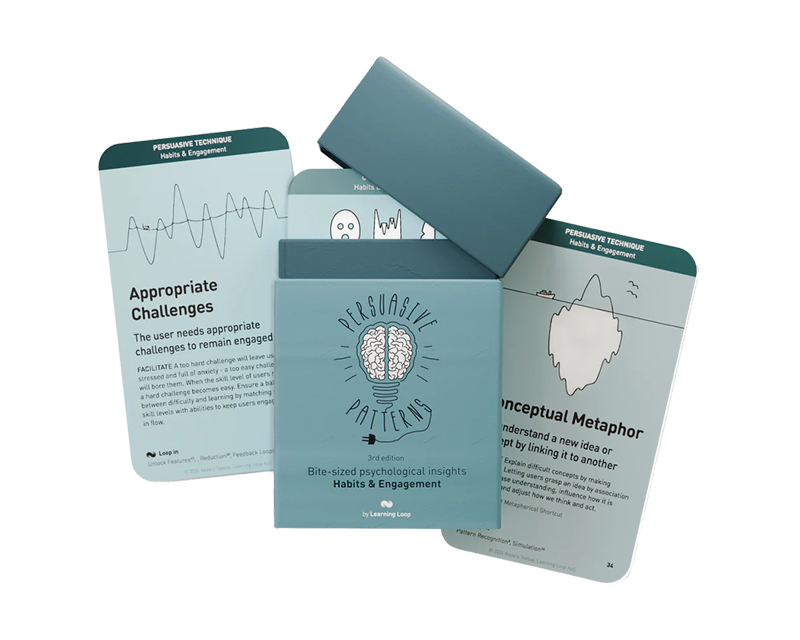Persuasive Patterns: Demonstration
Simulation
Give people first-hand insight into how inputs affect an output

Provide individuals with an interactive experience that mimics real-life processes or scenarios. This technique allows users to understand how their actions or decisions might influence outcomes, thereby offering insights into cause-and-effect relationships.
Imagine a group of friends deciding to start a small garden. They have no prior experience, so they use a gardening app that simulates various gardening conditions. The app allows them to input different variables like soil type, plant species, and watering schedules. As they adjust these inputs, the app shows potential outcomes, helping them understand how their choices might affect the growth of their plants. This hands-on experience with the simulation helps them make informed decisions when they actually start planting in their garden.
Similarly, fantasy football is another great example of the Simulation technique in action. In fantasy football, participants select real-world players to create virtual teams. The performance of these virtual teams is based on the actual performance of the players in real games. This simulation allows participants to understand how different players and strategies might affect their team’s performance. They can experiment with various combinations of players and observe the outcomes, gaining insights into team management and player performance. This simulation not only entertains but also educates users about football strategies and player capabilities.
The study
In the Stanford University study on virtual reality simulations and their impact on environmental behavior, researchers observed quantifiable changes in behavior and attitudes. Participants were divided into two groups: one experienced a virtual reality simulation of deforestation, and the other group read a detailed account of the same information.
Post-experiment, the group that underwent the virtual reality experience showed a 20% increase in conservation behavior, such as using fewer paper products, compared to the group that only read about deforestation. The virtual reality group also demonstrated a 30% stronger emotional connection to environmental issues, as measured by subsequent surveys and interviews. In follow-up tests conducted two weeks later, the virtual reality group retained significantly more information about deforestation, with a 25% higher recall rate than the reading group.
Bailenson, J.N., Yee, N., Merget, D., & Schroeder, R. (2006). The effect of behavioral realism and form realism of real-time avatar faces on verbal disclosure, nonverbal disclosure, interpersonal distance, and copresence in dyadic interaction. Presence: Teleoperators and Virtual Environments, 15(4), 359-372.
The use of simulation in design and communication provides hands-on experience, enabling individuals to experiment with different choices and see potential results in a controlled environment. This approach can be particularly effective in learning and decision-making contexts, where understanding the consequences of actions is crucial. By offering a safe space for trial and error, simulation can enhance learning, increase engagement, and influence behavior in a positive way.
The psychological underpinnings of simulations is deeply rooted in experiential learning and embodied cognition. These principles suggest that when individuals engage in simulations, they’re not just passively receiving information but actively participating in an experience that can lead to deeper cognitive processing.
Experiential learning theory, proposed by David Kolb, emphasizes the role of experience in the learning process. According to this theory, individuals gain concrete experience in a controlled, replicated environment when they engage in a simulation. This experience then leads to reflection, where they can observe and reflect about what they experienced. Through this reflection, they can form abstract concepts and generalize the experience to broader contexts. Finally, individuals apply these concepts in new situations, completing the learning cycle.
Embodied cognition, another key psychological principle, argues that cognitive processes are deeply rooted in the body’s interactions with the world. Simulations engage multiple senses, which can create a more holistic and impactful learning experience. By simulating real-world scenarios, individuals are more likely to form emotional connections, which can influence attitudes and decision-making. Engaging in simulated actions can lead to behavioral mimicry, where the actions performed in the simulation influence real-world behaviors.
The immersive nature of simulations can have a profound impact on behavior and attitudes:
- Increased empathy
By placing users in simulated environments, they can develop empathy and understanding for situations and perspectives different from their own. - Enhanced memory retention
Experiential and emotional engagement in simulations can lead to improved memory retention compared to passive learning methods. - Behavioral change
The experiential learning cycle, combined with the immersive and emotional aspects of simulations, can lead to more significant and lasting behavioral changes.
The psychological principles of experiential learning and embodied cognition highlight the power of simulations in creating impactful, emotionally resonant experiences that can lead to enhanced learning, memory retention, and behavior change. These principles explain why simulations, especially immersive ones like virtual reality, can be more effective than traditional learning methods in influencing attitudes and actions.
Designing products through Simulation
The foundation of any effective simulation begins with a clear understanding of the intended learning outcomes. What skills or knowledge should the user acquire by the end of the simulation? This clarity guides the entire design process, ensuring that each element of the simulation contributes towards these educational objectives. For instance, in a customer service simulation, real-life scenarios between employees and customers can be integrated to provide practical and relatable learning experiences.
A compelling story is at the heart of every engaging simulation. This narrative should not only captivate the user but also present relatable scenarios that mirror real-life challenges. The use of multimedia elements like videos, images, and interactive quizzes can enhance the storytelling, making the learning process more dynamic and less monotonous. The key is to create a narrative that resonates with the user, making the learning experience both meaningful and memorable.
It’s crucial to set clear expectations for the users. What should they gain from the simulation? Each module or section of the simulation should have distinct goals that are directly linked to tangible skills or improvements, such as enhanced decision-making abilities or better customer interactions. This clarity helps users understand the value of the simulation and what they can expect to achieve.
The level of interaction in a simulation is another critical aspect of its design. This ranges from basic question-and-answer formats to more elaborate setups involving avatars and virtual environments. The choice of interaction level should align with the overall objectives of the simulation, as well as budgetary and technological constraints. The goal is to create an interactive experience that is both engaging and effective in achieving the learning objectives.
An integral part of any learning process is assessment and feedback. Regular, short assessments throughout the simulation can help track progress and reinforce learning. Feedback should be constructive and tailored to the specific learning objectives of the simulation. This not only helps in measuring the effectiveness of the simulation but also provides valuable insights for continuous improvement.
When designing simulations aimed at behavior change, there are several key considerations that designers should keep in mind to ensure the effectiveness and impact of the simulation.
- Align simulations with behavioral goals
The design of the simulation should be directly tied to the specific behaviors you wish to change or influence. This means understanding the target behavior in depth – what motivates it, what barriers exist to changing it, and what outcomes are desired. The simulation should provide scenarios and challenges that directly relate to these aspects, allowing users to practice and understand the desired behavior in a controlled, simulated environment. - Incorporate realistic and relatable scenarios
For a simulation to effectively influence behavior, it needs to resonate with the user’s real-life experiences. Design scenarios that are authentic and relatable, reflecting the actual challenges and decisions that users face. This realism helps users to see the relevance of the simulation to their own lives, making the lessons learned more likely to be applied in real-world situations. - Utilize interactive elements
Engagement is key in any learning or behavior change process. Incorporate interactive elements such as decision-making points, branching scenarios, and immediate feedback. These elements not only make the simulation more engaging but also allow users to see the consequences of their choices in a risk-free environment, reinforcing the learning process. - Provide instant feedback and support
Feedback is crucial in guiding behavior change. The simulation should provide immediate and ongoing feedback on the user’s decisions and actions, highlighting both positive behaviors and areas for improvement. This feedback should be constructive and supportive, encouraging users to reflect on their choices and understand the impact of their actions. - Facilitate reflection and application
After completing the simulation, provide opportunities for users to reflect on their experiences and how they can apply what they’ve learned to their real-life behavior. This might include follow-up discussions, reflective exercises, or action planning. The goal is to bridge the gap between the simulated environment and real-world application, ensuring that the lessons learned in the simulation translate into actual behavior change.
Ethical recommendations
The potential for misuse lies in several areas, from data privacy to the emotional impact on users. To navigate these challenges, a set of best practices must be rigorously applied.
The foremost concern is the potential for manipulation through misrepresentation. Simulations, while powerful, are mere approximations of reality. Distorting or skewing data to sway user decisions undermines the credibility and ethical integrity of the simulation. It’s crucial for developers to prioritize accuracy and transparency, making it clear to users that these are modeled scenarios, not exact replicas of real life.
Privacy concerns are another critical issue. Simulations often use personal data to create tailored experiences. This practice necessitates strict adherence to data protection laws and ethical guidelines. Users must be fully informed about how their data is being used and must provide explicit consent. This approach not only protects user privacy but also builds trust.
Users might experience stress or anxiety as a result of these simulations. It’s essential to design these experiences thoughtfully and provide users with debriefing sessions and support, helping them process their experiences and mitigate any negative emotional impacts.
Consider the following recommendations for designing simulation experience ethically:
- Be transparent and accurate
Ensure that simulations are transparent in their objectives and limitations. They should accurately represent the data and scenarios without misleading the user. - Informed consent
Users should be informed about the nature of the simulation, the data it uses, and its intended purpose. Obtain consent, especially when personal data is involved. - Include disclaimers
Clearly state that the simulation is a modelled representation and not an exact replica of real-world scenarios. Encourage users to consider external factors and real-world complexities. - Debrief and support
Offer debriefing sessions, especially after simulations of sensitive or intense scenarios. Provide users with support and resources to process their experiences.
Real life Simulation examples
SimCity
In the gaming industry, Electronic Arts’ SimCity is a classic example where players build and manage a city, learning about urban planning and resource management.
Tesla
Tesla allows customers to customize their cars online. Users can select different features and immediately see how these choices impact the car’s appearance and performance, including range and speed.
Boeing
Boeing uses advanced flight simulators for pilot training. These simulators offer realistic flight experiences, helping pilots learn to handle various aircraft and flight conditions.
Trigger Questions
- How can we ensure our simulation aligns closely with real-world scenarios relevant to our users?
- In what ways can we simplify the user interface to enhance understanding without sacrificing depth?
- What are the key variables our users need to manipulate, and how can we make their impacts clear?
- How can we test our simulation with real users to ensure it meets their needs and expectations?
- What feedback mechanisms can we integrate to guide users through the simulation process?
- How can we use the simulation to not just inform but also engage and motivate our users?
Pairings
Simulation + Feedback Loops
Combining simulation with feedback loops offers real-time insights into actions and consequences. For instance, a financial planning app could use simulation to allow users to adjust investment amounts and immediately see the projected future value, reinforcing learning through immediate feedback.

Give people first-hand insight into how inputs affect an output

We are influenced by information that provides clarity on our actions
Simulation + Goal-Gradient Effect
The goal-gradient effect, which states that individuals are more motivated as they get closer to a goal, can be integrated with simulations to visually demonstrate progress towards a goal. This can be particularly effective in fitness or learning apps where users can see the impact of their daily actions on their long-term goals.

Give people first-hand insight into how inputs affect an output

Our motivation increases as we move closer to a goal
Simulation + Autonomy Bias
Empowering users with choices in a simulated environment aligns with the autonomy bias, where people prefer to have control over their actions. This combination can be seen in customizable product demos, where users can experiment with different features or settings to see how they would work in real life.

Give people first-hand insight into how inputs affect an output

We strive to feel in control
Simulation + Anchoring Bias
Utilizing anchoring bias, where initial information serves as a reference point, simulations can be designed to start with a default or suggested input, guiding user expectations and decisions from the outset. This is common in online shopping experiences where users can virtually try on clothes or see how furniture looks in their home.

Give people first-hand insight into how inputs affect an output

We tend to rely too heavily on the first information presented
Simulation + Commitment & Consistency
When users make choices in a simulated scenario, they are more likely to commit to those choices in real life, adhering to the principle of commitment and consistency. An example is a car configurator tool where customers customize their vehicle and are more likely to purchase it because they have invested time in personalizing it.

Give people first-hand insight into how inputs affect an output

We want to appear consistent with our stated beliefs and prior actions
Simulation + Sunk Cost Bias
This combination can be effective in educational or training simulations. As users invest more time in a simulated learning experience, the sunk cost bias makes them more likely to continue the course or training, increasing engagement and completion rates.

Give people first-hand insight into how inputs affect an output

We are hesitant to pull out of something we have put effort into
Simulation + Positive Mimicry
Positive Mimicry involves users adopting behaviors or attitudes seen as successful or desirable in others. When combined with Simulation, this can be particularly powerful. For instance, in a leadership training program, a simulation could allow users to mimic the decision-making processes of successful leaders in various scenarios. This not only reinforces the learning but also makes the experience more engaging and relatable. Users can ‘try on’ different leadership styles and see the outcomes, thus learning through the experience of mimicry. Incorporate models of positive behavior within the simulation for users to observe and emulate, present a range of scenarios where different approaches can be tested and compared – and provide feedback that encourages reflection on the outcomes of mimicked behaviors.

Give people first-hand insight into how inputs affect an output

We learn by comparing our behavior with the actions of others
Simulation + Role Playing
Role Playing allows users to step into different roles or perspectives, which can significantly enhance the depth of a simulation. In an educational context, for instance, students could use simulation to experience historical events from the perspective of different figures or groups. This not only deepens their understanding of the subject matter but also fosters empathy and a more nuanced view of complex issues. Design simulations that fully immerse users in the role they are playing, with details and context that bring the role to life and enable interactive elements that allow users to make choices and see the consequences of their actions within their assumed role to offer a range of different perspectives to broaden understanding and empathy.

Give people first-hand insight into how inputs affect an output

People act according to their persona
A brainstorming tool packed with tactics from psychology that will help you build lasting habits, facilitate behavioral commitment, build lasting habits, and understand the human mind. It is presented in a manner easily referenced and used as a brainstorming tool.
Get your deck!- Persuasive Technology: Using Computers to Change What We Think and Do by Fogg
- Motivating by Fogg, Danielson & Cueller
- Hahn, B. H., & Valentine, D. T. (2017). Chapter 13 – Simulation. In Simulation.
- Hocevar, R., Marson, F. P., Cassol, V., Braun, H., Bidarra, R., & Musse, S. (2012). From Their Environment to Their Behavior: A Procedural Approach to Model Groups of Virtual Agents.
- Escalas, J. E. (2004). IMAGINE YOURSELF IN THE PRODUCT: Mental Simulation, Narrative Transportation, and Persuasion. Journal of Advertising, 33, 37-48.
- Mayer, R. E. (2004). Should there be a three-strikes rule against pure discovery learning? American Psychologist, 59(1), 14-19.
- Kahneman, D., & Tversky, A. (1979). Prospect theory: An analysis of decision under risk. Econometrica, 47(2), 263-291.
- Seligman, M. E. P., & Csikszentmihalyi, M. (2000). Positive psychology: An introduction. American Psychologist, 55(1), 5-14.
- Skinner, B. F. (1954). The science of learning and the art of teaching. Harvard Educational Review, 24(2), 86-97.
- Bandura, A. (1986). Social foundations of thought and action: A social cognitive theory. Englewood Cliffs, NJ: Prentice-Hall.
- Bailenson, J.N., Yee, N., Merget, D., & Schroeder, R. (2006). The effect of behavioral realism and form realism of real-time avatar faces on verbal disclosure, nonverbal disclosure, interpersonal distance, and copresence in dyadic interaction. Presence: Teleoperators and Virtual Environments, 15(4), 359-372.
- Kolb, D. A. (1984). Experiential learning: Experience as the source of learning and development. Prentice-Hall.
- Lakoff, G., & Johnson, M. (1999). Philosophy in the Flesh: The Embodied Mind and its Challenge to Western Thought. Basic Books.
